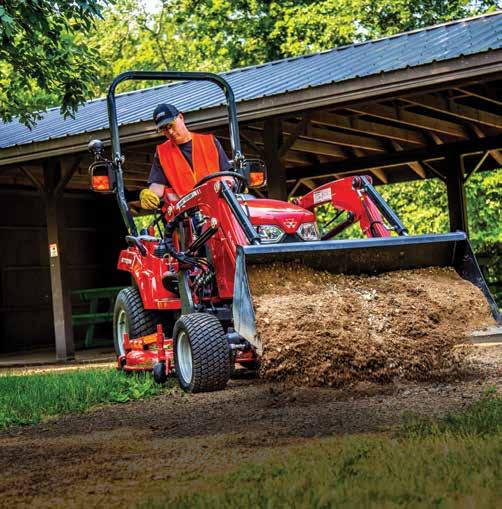
6 minute read
RURAL MUTUAL
A Look Back at 2019 Accomplishments L ast year was another success for Rural Mutual Insurance. Rural Mutual celebrated 85 years of providing insurance services in Wisconsin. Staff took a moment to reflect on how far the company has come, the association partnerships that have developed and the continuous financial strength.
Rural Mutual started the second decade of being selected as a Ward’s Top 50® Performer. For the 11th consecutive year, Rural Mutual has been recognized by The Ward Group, the leading provider of operational and compensation benchmarking and best practices studies for the insurance industry. Upon Peter Pelizza’s retirement, Dan Merk moved into the role of Executive Vice President and Chief Executive Officer. Rural Mutual made a monumental commitment to Wisconsin Farm Bureau’s centennial campaign as they aimed to raise $100,000 for agricultural education and leadership programs. Rural Mutual committed to matching all donations ($1-10,000) up to the $100,000.
Advertisement
For the third year in a row, Rural Mutual paid a 5 percent farm dividend, rewarding Wisconsin farmers.
Rural Mutual was a first-time sponsor of the Wisconsin State Fair, the state’s largest agricultural showcase and family entertainment park, and it’s supporting events including the Cream Puff 5K and Harvest Fair.
Rural Mutual once again took a concentrated effort in promoting safety around the farm, businesses and home. Staff highlighted safety presentations in high school agriculture classes, community safety days and at Wisconsin Farm Technology Days. Protecting the people of Wisconsin and what’s important to them continues to be an important focus.
For the 54th year, the company has sponsored the Wisconsin Interscholastic Athletic Association/Rural Mutual Sportsmanship Award and launched the sportsmanship matters campaign.
Thank you to Rural Mutual’s partners and policyholders who continue to put trust in the company’s knowledge and experience.
YOU’RE LIVING YOUR DREAM. NOW YOU CAN DRIVE IT, TOO.
You’ve always dreamed of owning your own farm, and being closer to the land. Now you’ve got it. And to work that land, you need just the right tractor: a GC1700, 1700E or 1700M Series compact tractor from Massey Ferguson®. Not too big. Not too small. With the versatility and ease-of-use to do the jobs that need to get done — from mowing, loading and backhoe work to snow blowing and hauling. Visit your Massey Ferguson dealer to learn more.
masseyferguson.us
Dealer Imprint Area CHECK OUT THE MASSEY FERGUSON GC1700, 1700E AND 1700M SERIES CHECK OUT THE MASSEY FERGUSON GC1700, 1700E AND 1700M SERIES ANTIGO SLINGER
© 2018 AGCO Corporation. Massey Ferguson is a brand of AGCO Corporation. AGCO ® and Massey Ferguson ® are trademarks of AGCO. All rights reserved. MF18TK007CRv02 SWIDERSKI EQUIPMENT, INC. STRUPP IMPLEMENT, INC.
CHILTON D & D EQUIPMENT CO. INC. 920-849-9304 www.ddequipment.com
Dryer Maintenance at Home and on the Farm W hen was the last time you inspected and cleaned your clothes dryer? Like many appliances, as long as it is working many people give little thought to preventive maintenance. Dryers are unique among home appliances in that they generate high amounts of heat along with highly combustible lint.
Each year there are approximately 2,900 fires in the U.S. that originate with a clothing dryer causing in excess of $35 million in property loss and averaging five deaths and 100 injuries. Like any other fire, these incidents are easily preventable with some basic preventative maintenance. Often there are simple warning signs that are overlooked or dismissed simply as, “Well, that dryer is x years old … it’s not going to work as well as when it was brand new.”
A couple of months ago my own dryer started experiencing issues. After placing a load in the machine to dry, I noticed that it occasionally wasn’t running as long as it normally should. On other occasions, the clothes weren’t fully dried despite running a full cycle. After a week or so, my dryer started beeping and displaying an error code. Like everyone, I’m guilty of procrastinating from time to time and kept resetting the dryer until the load was dry. After a week of this, I began pulling the machine apart anticipating that the problem was probably the result of lint buildup somewhere in the exhaust pipe.
After unplugging and pulling the machine away from the wall, I removed the front panel to access the underside of the lint trap. I was astonished to find that the heating element located just a scant two to three inches from the trap was blackened and deformed. The heating element had failed and began arcing between the coils and the metal housing. Had I not routinely cleaned my lint traps and exhaust pipe, this surely would have resulted in a fire.
As a fire investigator, I’ve dealt with numerous dryer fires over the years. One of my first questions to a homeowner is, “When was the last time you cleaned your lint trap and vent pipe?” Often, they have routinely pulled the filter but never gave a thought to running a brush through the vent pipe. On multiple occasions, I’ve found the screen on the exterior vent completely packed with lint to the point there was no air flow. Sometimes dryer fires are a result of an electrical malfunction with no warning. On a farm visit with one of our insurance agents, we were reviewing the mechanicals room in the milking parlor. Our loss control staff uses thermographic cameras to inspect electrical and mechanical components throughout each property looking for potential problems. On this visit, we found that the dryer in the parlor was in the process of experiencing a failure. Heat readings in excess of 400 F were found by the control panel, opposite of the heating exhaust. A fire was imminent and would have caused a significant impact to the farm had we not been in the right place, at the right time with the right equipment.
Unfortunately, this story isn’t an anomaly. As farms continue to increase in complexity, many are finding that investing less than $400 to purchase a thermal imaging camera with your Farm Bureau member discount through Grainger is money well spent. Beyond fire safety, these tools are immensely helpful with general mechanical and electrical preventive maintenance. In many instances preventing a dryer fire is as simple as; 1. Clean dryer vent pipe at least every three months. If significant lint buildup is found, consider more frequent cleanings as well as contacting a qualified appliance repair professional to inspect your dryer. 2. Never use coiled-wire foil or plastic venting. Dryer vents should be rigid, non-ribbed metal ducts. 3. Routinely inspect exterior vent for blockages from lint, animal or insect activity. 4. Maintain a clear area around the dryer, and don’t allow clothing or other combustibles to pile up. If a fire does occur, this will help slow the spread of flames. 5. Don’t dry items with foam, plastic or rubber components, e.g., a floor rug with a rubber backing should be hung to dry. An ounce of prevention is always worth a pound of cure. Taking a few extra minutes to conduct some basic preventative maintenance will help to reduce the likelihood of a fire. This article was written by Chris Schlechta, Rural Mutual Insurance Company's Safety and Loss Control Manager.













